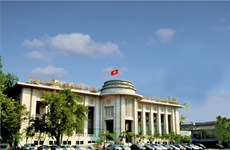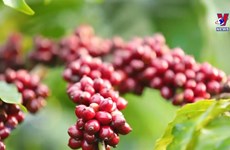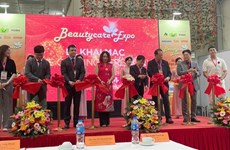Farmers cash in on cocoa market surge
In Central Highland Dak Lak province, a certain crop is having a big
impact on the lives of local ethnic communities - it is cocoa.
In Central Highland Dak Lak province, a certain crop is having a big
impact on the lives of local ethnic communities - it is cocoa.
Although cocoa is still only one of the seven top agricultural plants in the region, the newly imported plant has spread far and wide in a place where cashew nuts and coffee were previously seen as the mainstay of the province's agricultural industry.
With surging demand from Asia and shrinking production in West Africa, a global shortfall in cocoa output of around 160,000 tonnes in 2013 and about 1 million tonnes will occur by 2020, according to Dinh Hai Lam, cocoa development manager at MARS Incorporated.
With multinational companies the likes of Cargill and Mars wanting to grab their slice of Vietnam's emerging cocoa industry, despite it yielding only 6,700 tonnes of beans per year, an opportunity has emerged for Dak Lak farmers to cash in on this market driven frenzy and dramatically to improve their standard of living.
For Hbim Kbrong, a M'Nong woman in Yang Tao Commune's Phok Village, her new cocoa crops have transformed her livelihood after she decided to replace her family's poor-yielding coffee crops with cocoa in 2007.
In the sand-laden area of Yang Tao commune in LaK District, locals used to depend on short-term plants like corns or cassava to supplement poor returns from coffee. However, all this has changed since cocoa was introduced through the Sustainable Cocoa Enterprise Solutions for Smallholders (SUCCESS) Alliance programme in Vietnam.
The programme, a public-private partnership driven by USAID, USDA, the World Cocoa Foundation, Mars Inc. and ACDI/VOCA, provided Hbim's family and nearly 40 others between 150 and 200 young cocoa plants each, fertiliser and technical training on how to grow cocoa plants.
After just three years, her cocoa garden was providing 400 kilos of dried-cocoa beans. She sold the beans and received more than 22.4 million VND (approximately 1,060 USD) for her efforts.
"That was the most money I'd ever had at that moment," said Hbim.
Her life has improved in leaps and bounds from that moment thanks to a regular source of income from cocoa. She says that her family used to ‘live in misery' when they had to collect firewood and bamboo shoots from the forest and trade them for rice in the dry season.
"The cocoa usually provides beans for 9-10 months a year. Now, I have a regular source of income to buy food, clothes, meat and fish for my family. My son can go to school and I have time to participate in community social activities such as the commune's women's and farmer's unions."
Hbim said she received more than 70 million VND (3,300 USD) from her 400 cocoa plants in 2012 and her family's income will double in coming years when all 900 cocoa plants start producing beans.
She has managed to save 125 million VND (6,000 USD) to build a house, pay for her daughter's wedding and buy more land for her cocoa garden.
Hbim's family is one of 80 households (approx. half of the commune) who have escaped poverty thanks to cocoa farming.
But she hasn't stopped there. She is also now leader of the commune's cocoa growing club, organising monthly meetings to discuss cocoa growing techniques and share valuable knowledge.
In Lak district, there are now 262 hectares of cocoa land belonging to 45 cocoa clubs with more than 2,100 participating farmers.
The impetus to raise incomes has also led to innovations in growing hybrid crops, with farmers in neighbouring Eakar district planting cocoa trees alongside cashew nuts.
The model has showed remarkable results with 200 members now growing 350ha of cocoa and cashew nuts in hamlet 12 alone. In 2013, the district harvested 80 tonnes of dried cocoa beans.
"No other plants beside cocoa would be planted in cashew nut gardens. Cocoa plants have doubled my income to 60 million VND (2,900 USD) per hectare," said co-operative chairman Thai Xuan Quang.
"Coffee is still the number one plant in Dak Lak. However, cocoa has showed it's a strong competitor when it is grown alongside other plants or in small plots," said the province's agriculture and rural development deputy director Huynh Quoc Thich.
Thich highlights an important point that Dak Lak still faces difficulties developing cocoa farming due to a shortage of land, capital and technical support for farmers with no experience growing the plant.
In spite of this, there are positive signs this plant will continue to make its mark on Dak Lak. The province currently has 2,500ha of cocoa and there is even a master plan for 6,000ha of cocoa farming to be implemented by 2015.
The Ministry of Agriculture and Rural Development's Cultivation Department has also recently said cocoa farming has increased from 9,000ha in 2007 to more than 22,000ha across the country, with growth mainly concentrated in the Central Highlands, south-eastern and Mekong Delta provinces.
"It presents a great opportunity for Vietnam to become one of the world's major cocoa suppliers. There are opportunities here for all cocoa growers," said Lam.-VNA
Although cocoa is still only one of the seven top agricultural plants in the region, the newly imported plant has spread far and wide in a place where cashew nuts and coffee were previously seen as the mainstay of the province's agricultural industry.
With surging demand from Asia and shrinking production in West Africa, a global shortfall in cocoa output of around 160,000 tonnes in 2013 and about 1 million tonnes will occur by 2020, according to Dinh Hai Lam, cocoa development manager at MARS Incorporated.
With multinational companies the likes of Cargill and Mars wanting to grab their slice of Vietnam's emerging cocoa industry, despite it yielding only 6,700 tonnes of beans per year, an opportunity has emerged for Dak Lak farmers to cash in on this market driven frenzy and dramatically to improve their standard of living.
For Hbim Kbrong, a M'Nong woman in Yang Tao Commune's Phok Village, her new cocoa crops have transformed her livelihood after she decided to replace her family's poor-yielding coffee crops with cocoa in 2007.
In the sand-laden area of Yang Tao commune in LaK District, locals used to depend on short-term plants like corns or cassava to supplement poor returns from coffee. However, all this has changed since cocoa was introduced through the Sustainable Cocoa Enterprise Solutions for Smallholders (SUCCESS) Alliance programme in Vietnam.
The programme, a public-private partnership driven by USAID, USDA, the World Cocoa Foundation, Mars Inc. and ACDI/VOCA, provided Hbim's family and nearly 40 others between 150 and 200 young cocoa plants each, fertiliser and technical training on how to grow cocoa plants.
After just three years, her cocoa garden was providing 400 kilos of dried-cocoa beans. She sold the beans and received more than 22.4 million VND (approximately 1,060 USD) for her efforts.
"That was the most money I'd ever had at that moment," said Hbim.
Her life has improved in leaps and bounds from that moment thanks to a regular source of income from cocoa. She says that her family used to ‘live in misery' when they had to collect firewood and bamboo shoots from the forest and trade them for rice in the dry season.
"The cocoa usually provides beans for 9-10 months a year. Now, I have a regular source of income to buy food, clothes, meat and fish for my family. My son can go to school and I have time to participate in community social activities such as the commune's women's and farmer's unions."
Hbim said she received more than 70 million VND (3,300 USD) from her 400 cocoa plants in 2012 and her family's income will double in coming years when all 900 cocoa plants start producing beans.
She has managed to save 125 million VND (6,000 USD) to build a house, pay for her daughter's wedding and buy more land for her cocoa garden.
Hbim's family is one of 80 households (approx. half of the commune) who have escaped poverty thanks to cocoa farming.
But she hasn't stopped there. She is also now leader of the commune's cocoa growing club, organising monthly meetings to discuss cocoa growing techniques and share valuable knowledge.
In Lak district, there are now 262 hectares of cocoa land belonging to 45 cocoa clubs with more than 2,100 participating farmers.
The impetus to raise incomes has also led to innovations in growing hybrid crops, with farmers in neighbouring Eakar district planting cocoa trees alongside cashew nuts.
The model has showed remarkable results with 200 members now growing 350ha of cocoa and cashew nuts in hamlet 12 alone. In 2013, the district harvested 80 tonnes of dried cocoa beans.
"No other plants beside cocoa would be planted in cashew nut gardens. Cocoa plants have doubled my income to 60 million VND (2,900 USD) per hectare," said co-operative chairman Thai Xuan Quang.
"Coffee is still the number one plant in Dak Lak. However, cocoa has showed it's a strong competitor when it is grown alongside other plants or in small plots," said the province's agriculture and rural development deputy director Huynh Quoc Thich.
Thich highlights an important point that Dak Lak still faces difficulties developing cocoa farming due to a shortage of land, capital and technical support for farmers with no experience growing the plant.
In spite of this, there are positive signs this plant will continue to make its mark on Dak Lak. The province currently has 2,500ha of cocoa and there is even a master plan for 6,000ha of cocoa farming to be implemented by 2015.
The Ministry of Agriculture and Rural Development's Cultivation Department has also recently said cocoa farming has increased from 9,000ha in 2007 to more than 22,000ha across the country, with growth mainly concentrated in the Central Highlands, south-eastern and Mekong Delta provinces.
"It presents a great opportunity for Vietnam to become one of the world's major cocoa suppliers. There are opportunities here for all cocoa growers," said Lam.-VNA













